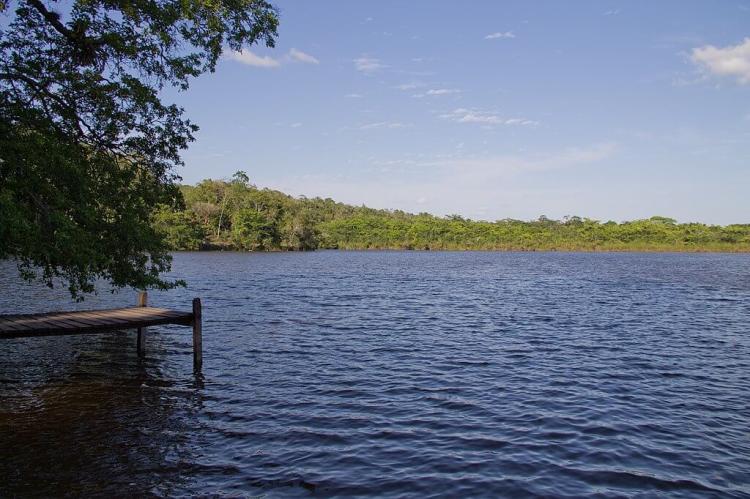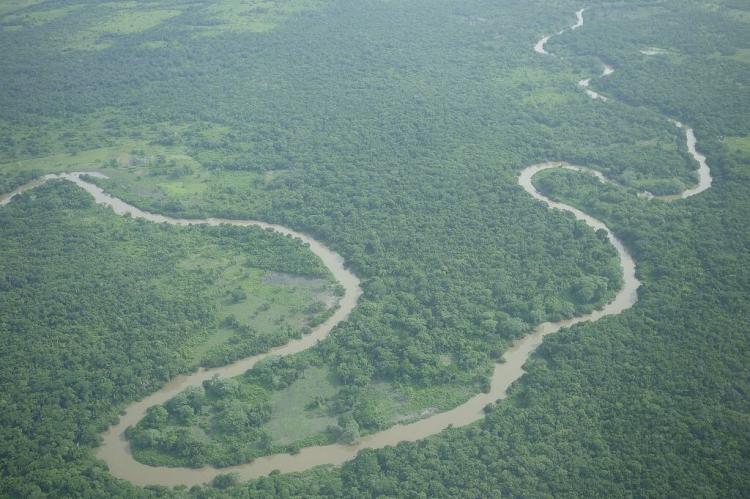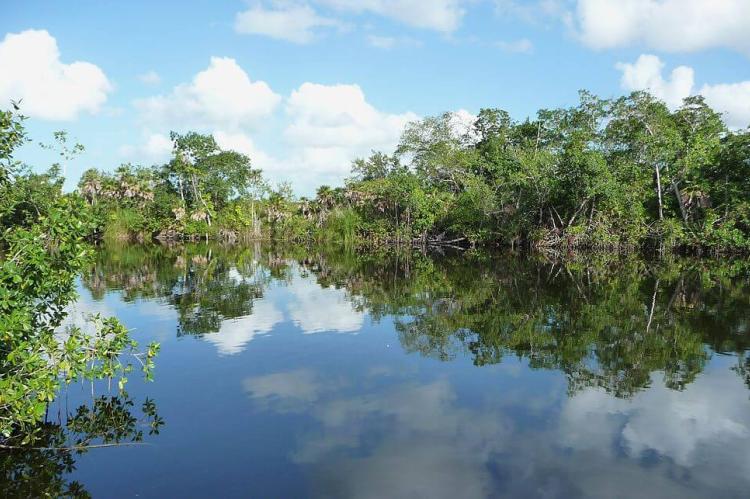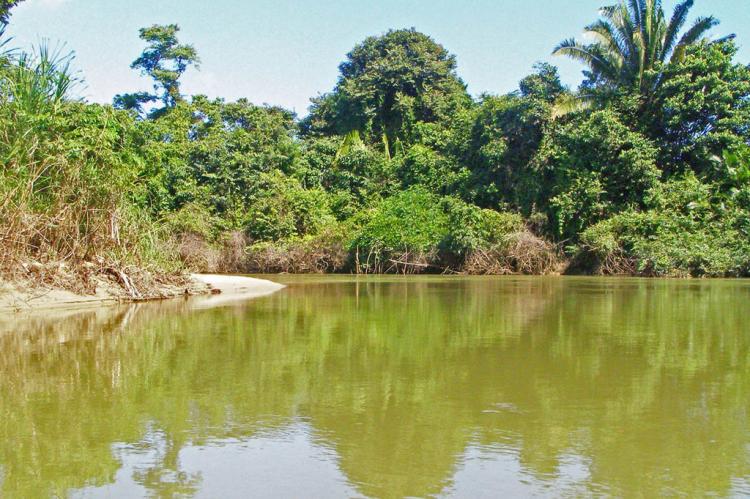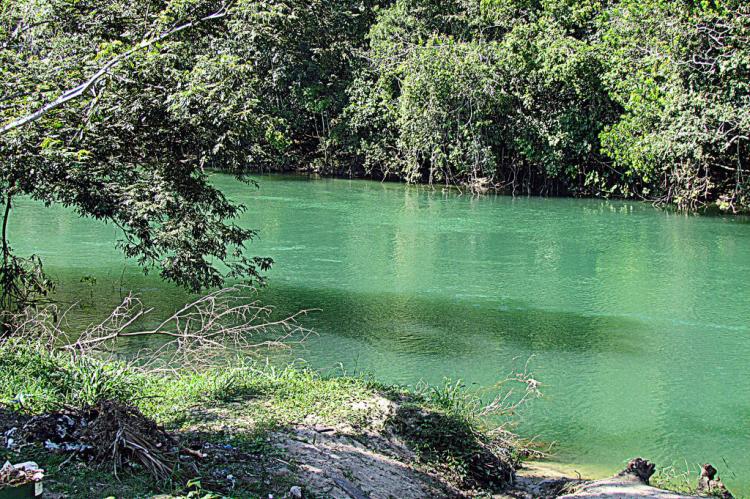Water Bodies of Belize
Belize's water resources, including lakes, lagoons, and approximately 35 major rivers, notably the Belize River, are vital for drinking, agriculture, and hydroelectric generation. Beyond their essential roles, these water bodies are hubs for recreational activities such as fishing, swimming, and rafting.
Water Bodies of Belize
Belize is nestled along the Caribbean Sea and boasts a remarkable natural landscape adorned with captivating water bodies. Its coastline is a mesmerizing tapestry of pristine beaches and the renowned Belize Barrier Reef Reserve System, a UNESCO World Heritage site celebrated for its unparalleled biodiversity.
Dotted along the coast are picturesque cayes (islands) and atolls, inviting adventurers to explore their vibrant underwater realms through exceptional snorkeling and diving experiences.
Inland, Belize's network of pristine rivers, including the meandering Belize River, winds through lush rainforests, offering a serene backdrop for exploration and wildlife encounters. Surrounding these waterways are numerous lagoons, mangrove forests, and coastal wetlands, providing vital habitats for a diverse array of marine and bird species.
Despite its rich hydrological features, Belize's topography is notably devoid of large-scale dams or significant reservoirs for water management or hydroelectric power generation, preserving its natural beauty and ecological integrity.
The water bodies of Belize are not only a source of immense natural beauty but also play a crucial role in the country's economy, serving as habitats for diverse wildlife and offering unparalleled opportunities for recreation and tourism. Whether diving into the depths of the Caribbean Sea or embarking on a tranquil river journey through the heart of the rainforest, Belize's water wonderland promises unforgettable experiences for adventurers and nature enthusiasts alike.
Gulfs and Bays
Gulf of Honduras: The Gulf of Honduras is a large inlet of the Caribbean Sea, indenting the coasts of Belize, Guatemala, and Honduras. It is a popular destination for fishing, sailing, and scuba diving. The gulf is home to various wildlife, including manatees, crocodiles, dolphins, and fish.
Amatique Bay: Amatique Bay is a large bay in the Gulf of Honduras, along the eastern coast of Guatemala and Belize. It stretches from Santo Tomás de Castilla in the south to Punta Gorda in the north, where it opens to the Caribbean Sea.
Chetumal Bay: Situated in the northernmost part of Belize, Chetumal Bay forms part of the border between Mexico and Belize. It is an expansive bay with diverse marine life and mangrove ecosystems. The bay also has several islands, including Ambergris Caye and Caye Caulker.
Corozal Bay: Located in northern Belize near the town of Corozal, Corozal Bay is a shallow bay extending into the Caribbean Sea. It is known for its calm waters and is a popular spot for boating and fishing.
Placencia Bay: Found in southeastern Belize, Placencia Bay is a picturesque bay along the Placencia Peninsula. It is known for its beautiful sandy beaches, clear waters, and vibrant coral reefs. The bay offers opportunities for swimming, snorkeling, and diving.
Stann Creek Bay: Stann Creek Bay is a large bay in the southeastern part of Belize. Guatemala borders it to the east and Belize to the west. The bay is a popular fishing, sailing, and scuba diving destination.
Lakes and Lagoons
Belize is a small country bordered by the Caribbean Sea on the east and Mexico and Guatemala on the west. The country has a long coastline, and many rivers and streams flow into the sea. These rivers and streams often form lagoons as they slow down and deposit sediment.
Belize has a tropical climate, with a rainy season from May to October and a dry season from November to April. The rainy season causes the rivers and streams to swell, which can lead to the formation of new lagoons. In addition, Belize is located on a limestone shelf, a type of rock that is porous and easily dissolved by water, which means that lagoons can form as the limestone bedrock is dissolved by rainwater. The combination of these factors has led to many lagoons in Belize. These lagoons are home to various wildlife, including fish, birds, and crocodiles. They are also popular destinations for tourists who enjoy fishing, kayaking, and birdwatching.
Aguacate Lagoon: Aguacate Lagoon is a lake and private reserve near the Mennonite community Spanish Lookout in western Belize. The lagoon is an herbaceous swamp with permanent waterlogged vegetation and is a popular spot for birdwatching, hiking, and canoeing. It is also home to an unexcavated ancient Maya site.
Black Creek Lagoon: Black Creek Lagoon is a large shallow lagoon approximately 20 km (12 mi) long and 5 km (3 mi) wide in the Belize District of Belize. It is a part of the Crooked Tree Wildlife Sanctuary, a protected area home to various wildlife, including jaguars, crocodiles, monkeys, and birds.
Button Lagoon: Button Lagoon is a shallow lagoon approximately 2 km (1.2 mi) long and 1 km (0.6 mi) wide in Belize's Orange Walk District. It is a part of the Buttonwood Nature Reserve, a protected area home to various wildlife, including birds, crocodiles, and fish.
Cenote Lagoon: Cenote Lagoon is a shallow lagoon approximately 1 km (0.6 mi) long and 500 m (0.3 mi) wide in the Corozal District of Belize. It is a part of the Rio Bravo Conservation and Management Area, a protected area home to various wildlife, including birds, crocodiles, and fish.
Chan Lagoon: Chan Lagoon is a small lagoon in the Orange Walk District of Belize. It is a part of the Chan Chich Nature Reserve, a private reserve home to various wildlife, including jaguars, crocodiles, monkeys, and birds. The lagoon is approximately 1 km (0.6 mi) long and 500 m (0.3 mi) wide. A small stream feeds it, and mangroves surround it.
Chiwa Lagoon: Chiwa Lagoon is a small lagoon in Belize's Orange Walk District. It is a part of the Chiwa Forest Reserve, a protected area home to various wildlife, including birds, crocodiles, and fish. The shallow lagoon is approximately 1.5 km (0.9 mi) long and 1 km (0.6 mi) wide. A small stream feeds it, and mangroves surround it.
Cocos Lagoon: Cocos Lagoon is a freshwater lagoon in Belize's Corozal District. It is approximately 15 km (9.3 mi) long and 5 km (3.1 mi) wide. The New River feeds the shallow lagoon, and mangroves surround it.
Cook's Lagoon: Cook's Lagoon is a freshwater lagoon in the Belize District of Belize. It is approximately 2 km (1.2 mi) long and 1 km (0.6 mi) wide. A small stream feeds the shallow lagoon, surrounded by mangroves.
Cox Lagoon: Cox Lagoon is a freshwater lagoon in Belize's Cayo District. It is approximately 10 km (6.2 mi) long and 5 km (3.1 mi) wide. The Mopan River feeds the lagoon, and mangroves surround it.
Crabcatcher Lagoon: Crabcatcher Lagoon is a large, winding lagoon in the Orange Walk District of Belize. It is approximately 45 km (28 mi) long and 1.6 km (1 mi) wide, and rainforests and mangroves surround it. The Mayans formed the lagoon and used it as a water source and a place to catch crabs. The lagoon is still home to a variety of crabs, as well as fish, turtles, and other wildlife.
Cudjoe Lagoon: Cudjoe Lagoon is a large freshwater lagoon in Belize's Corozal District. It is approximately 325 ha (800 acres) in size, and rainforests and mangroves surround it. The Mayans formed the lagoon and used it as a water source and a place to fish. The lagoon is still home to a variety of fish, as well as turtles, caimans, and other wildlife. It is a popular destination for fishing, birdwatching, and kayaking.
Doubloon Bank Lagoon: Doubloon Bank Lagoon is a large freshwater lagoon in the Orange Walk District of Belize. It is approximately 11 sq km (4.3 sq mi), and rainforests and mangroves surround it. The Mayans formed the lagoon and used it as a water source and a place to fish. The lagoon is still home to a variety of fish, as well as turtles, caimans, and other wildlife.
Fabers Lagoon: Fabers Lagoon is a small freshwater lagoon in the Belize District of Belize. It is approximately 3 sq km (1.2 sq mi), and mangroves and rainforests surround it. The Mayans formed the lagoon and used it as a water source and a place to fish. It is a popular destination for birdwatching, fishing, and kayaking.
Four Mile Lagoon: Four Mile Lagoon is a large freshwater lagoon in Belize's Corozal District. It is approximately 6.5 sq km (2.5 sq mi) in size, and mangroves and rainforests surround it. The Mayans formed the lagoon and used it as a water source and a place to fish. It is a popular destination for fishing, birdwatching, and kayaking.
Northern Lagoon: Northern Lagoon is a large, shallow lagoon in the Belize District of Belize. It is approximately 31 sq km (12 sq mi), and mangroves and rainforests surround it. The Mayans formed the lagoon and used it as a water source and a place to fish. It is still home to a variety of fish, as well as turtles, caimans, and other wildlife.
Southern Lagoon: Southern Lagoon is a large, brackish lagoon in the Belize District of Belize. It is approximately 36 sq km (14 sq mi), and mangroves and rainforests surround it. The Mayans formed the lagoon and used it as a water source and a place to fish. It is a popular destination for fishing, birdwatching, and kayaking.
Almond Hill Lagoon: Almond Hill Lagoon is a small lake in Belize's Cayo District. It is approximately 1.3 sq km (0.5 sq mi) in size, and hills and forests surround it. The collapse of a limestone cave formed the lake, fed by underground springs. The lake is a popular destination for swimming, kayaking, and birdwatching.
Big Pond: Big Pond is a freshwater lake in the Stann Creek District of Belize. It is approximately 1.7 sq km (0.66 sq mi), surrounded by rainforest and savannah. The collapse of a limestone cave formed the lake, fed by underground springs. It is a popular destination for birdwatching, hiking, and fishing.
Emerald Lake: Emerald Lake is a glacial lake in Belize's Cayo District. It is approximately 1.9 km (1.2 mi) long and 0.8 km (0.5 mi) wide, and mountains surround it. The lake was formed by a glacier that retreated over 10,000 years ago. It is a popular destination for hiking, swimming, and kayaking.
Five Blues Lake: Five Blues Lake is a small lake in Belize's Cayo District, approximately 4 ha (10 acres) in size. It is named for the five different shades of blue that can be seen in its water. The lake is thought to have been formed by a sinkhole and is fed by underground springs. It is surrounded by rainforest and limestone hills and is a popular destination for swimming, kayaking, and birdwatching.
Hickatee Lake: Hickatee Lake is a small lake in the Toledo District of Belize. It is named after the Central American river turtle, or hicatee, found in the lake. The lake is approximately 2.4 km (1.5 mi) long and 0.8 km (0.5 mi) wide, surrounded by rainforest. The lake is popular for wildlife viewing, fishing, and hiking.
Vaca Lake: Vaca Lake is an artificial lake in Belize's Cayo District. It is approximately 10 km (6 mi) long and 1.6 km (1 mi) wide, and rainforests and mountains surround it. The lake was created in the 1960s when the Vaca Dam was built to provide hydroelectric power to the area. The dam created a reservoir that flooded a large area of rainforest. It is a popular destination for fishing, boating, and birdwatching.
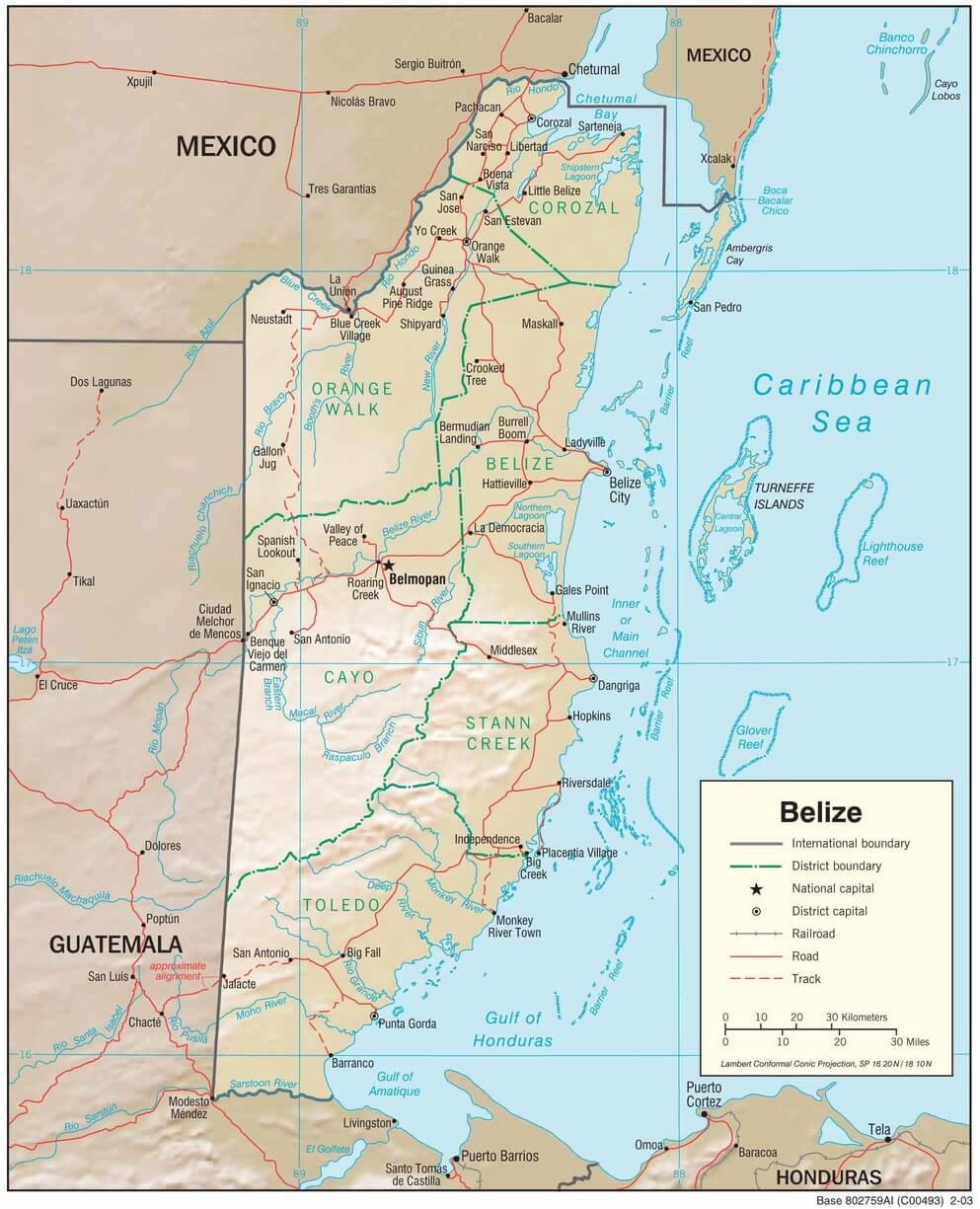
Belize physiographic map.
Rivers
Belize River (Old River): The Belize River is the longest in Belize, stretching approximately 290 km (180 mi) across the country. It originates in the Maya Mountains and flows through the Cayo District, passing near the capital city, Belmopan, before reaching the Caribbean Sea near Belize City. The river is essential for transportation, irrigation, and supporting various ecosystems.
Bladon River: The Bladen River is a tributary of the Monkey River in the Toledo District of Belize. It is approximately 35 km (22 mi) long and flows through the Bladen Nature Reserve.
Hondo River: The Hondo River forms a portion of Belize's border with Mexico. Approximately 150 km (93 mi) long, It originates in Guatemala and flows northward through Belize, passing through the Orange Walk District. The Hondo River plays a vital role in agriculture and transportation and provides habitat for various wildlife species.
Macal River: The Macal River is one of the major tributaries of the Belize River. It is 198 km (123 mi) long, originates in the Maya Mountains, and flows through the Cayo District, passing through San Ignacio and the Mountain Pine Ridge Forest Reserve. The Macal River is famous for kayaking, canoeing, and river tubing.
Manatee River: The Manatee River is a coastal watercourse in the Belize District of Belize. It consists of two parts, one on the western side of the Southern Lagoon and the other connecting the eastern side of the Southern Lagoon with the Caribbean Sea.
Moho River: The Moho River flows through the Toledo District in southern Belize. Approximately 31 km (19 mi) in length, it originates in the Maya Mountains and empties into the Caribbean Sea near Punta Gorda. The Moho River is surrounded by lush vegetation and is culturally and ecologically significant.
Monkey River: The Monkey River is a scenic river that flows through the southern part of Belize. It is 64 km (40 mi) long and is a popular destination for fishing, kayaking, and jungle tours.
Mopan River: Another vital tributary of the Belize River, the Mopan River originates in the Maya Mountains and flows through the Cayo District. It is 31 km (19 mi) long. It joins the Macal River near the town of San Ignacio to form the Belize River. The Mopan River is known for its scenic beauty and is utilized for recreational activities.
Mullin River: The Mullins River is in the Stann Creek District of Belize. It is approximately 40 km (25 mi) long and flows through the Stann Creek Valley.
New River: New River is a large river that flows through the Orange Walk District in northern Belize. It is 82 km (51 mi) long and is a popular destination for fishing, kayaking, and birdwatching. It originates in the Yalbac Hills and meanders through lagoons and wetlands before emptying into Chetumal Bay. The New River is known for its diverse wildlife, including crocodiles and manatees, and provides access to the Lamanai Mayan Ruins.
North Stann Creek River: The North Stann Creek River is in the Stann Creek District of Belize. It is approximately 40 km (25 mi) long and flows through the North Stann Creek Valley.
Sarstoon River: The Sarstoon River is the southernmost river in Belize. It is 160 km (100 mi) long and forms the border between Belize and Guatemala. The Sarstoon River is a popular destination for fishing, kayaking, and birdwatching.
Sibun River (Xibun River): The Sibun River is in central Belize and flows through the Belize District. It has its source in the Maya Mountains and meanders through tropical forests before reaching the Caribbean Sea. The Sibun River is famous for river tubing and offers opportunities to explore its surrounding ecosystems.
Sittee River: The Sittee River is a river in central Belize that flows through the Stann Creek District. It is approximately 40 km (25 mi) long and flows from the Maya Mountains to the Caribbean Sea.
Temash River: The Temash River is a river that flows through the Toledo District of Belize. It is approximately 84 km (52 mi) long and flows from the Maya Mountains to the Caribbean Sea.
